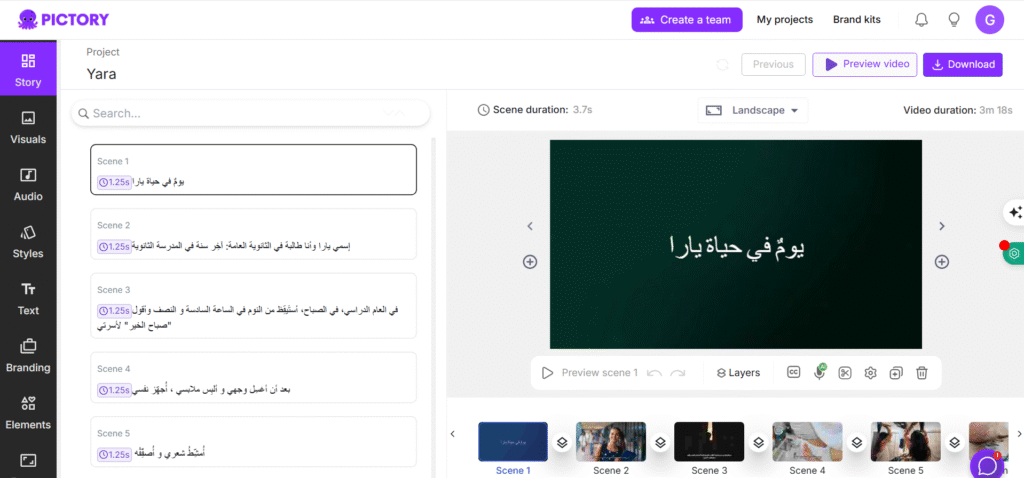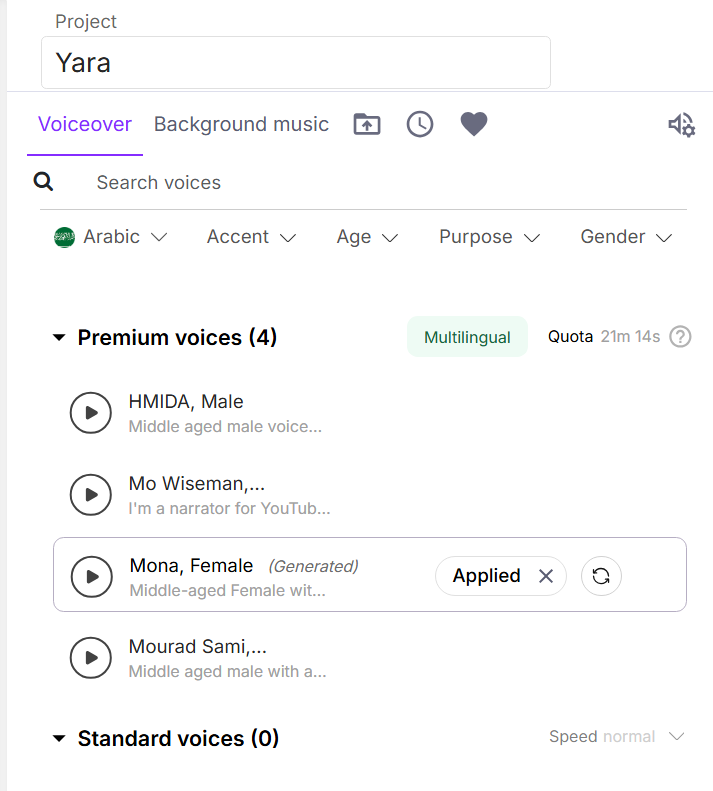
Enhancing Language and Culture Courses with Pictory
By Gisele El Khoury, St. Lawrence University

DOI: https://www.doi.org/10.69732/WEYZ7787
Introduction
As language educators, we constantly seek ways to make our students’ learning more engaging and meaningful, especially in online and hybrid settings where the connection can feel distant. While textbooks may include visuals and stories, digital storytelling tools offer a more immersive and dynamic way to engage students with culture and vocabulary. For the past couple of months, I’ve had the privilege of collaborating with Dr. Nevine Abraham, Associate Teaching Professor and Coordinator of Arabic Studies at Carnegie Mellon University, to produce an online Arabic course for second-semester learners. In this course, we used a variety of tools (such as Synthesia and HeyGen) to make engaging videos with rich visuals that help explain vocabulary, model conversations, and animate culture. We also used Pictory, an AI video creation platform, a tool that we have come back to repeatedly because of its intuitive interface, scene-by-scene editing, and surprisingly accurate AI-generated Arabic voiceovers, which provided students with clear and consistent pronunciation modeling.
In this article, I will introduce what Pictory is and what it does, explain how it works, and walk through examples of how it can be meaningfully applied in Arabic and other world language classrooms to enhance student learning.
What is Pictory?
Pictory is an AI video creation platform that transforms short texts (such as scripts, blog posts, or lesson summaries) into polished videos with visuals, audio, and subtitles. It is easy to use for tasks like dragging and dropping scenes, selecting visuals, and adding voiceovers, making it accessible to both instructors and students with little to no video editing experience. Its versatility lies in supporting a wide range of projects, from lecture recaps and cultural narratives to student-created video essays and pronunciation practice. It is built for simplicity and speed, and provides automated video and image matching, text, subtitling, automatic voiceovers, and editing tools. Pictory is an excellent resource for educators and students who want to create interesting and engaging video content on a practical, “low-tech” level without sacrificing key elements like scene sequencing, subtitles, voiceovers, or visual coherence, and without the need to use advanced editing.
Pictory Tool Overview
| Feature | Description |
| Name of the Tool | Pictory |
| URL | https://pictory.ai |
| Primary Purpose | AI-powered video creation from text/scripts, blog posts, URLs, or video highlights. |
| Cost (as of June 2025) |
|
| Ease of Use | Drag-and-drop User Interface; intuitive workflows |
Understanding the Pictory Interface
One of the strengths of Pictory is its user-friendly and visually organized interface, which makes it accessible to both educators and students with minimal technical experience. Upon logging in and creating a project, users are taken to a dashboard that includes several clearly labeled sections:
- Story Panel (Left Sidebar): This section displays each scene with its accompanying text. Scenes are listed in sequence and can be reordered or edited easily. Each scene’s duration is adjustable.
- Preview Panel (Center): This is where the current scene is visualized. Users can click through scenes and preview how the text and visuals align. The scene duration and layout (landscape/portrait) can be customized above the video frame.
- Media Navigation Bar (Bottom): In this section, users can scroll through all video scenes like slides, viewing and rearranging them with a simple drag-and-drop motion. Each scene displays a thumbnail preview for easy identification.
- Toolbar (Left Sidebar): Additional tools for selecting visuals, adding audio or music, customizing styles, inserting text overlays, uploading logos in branding, or adding stickers and graphics in elements are neatly listed. These features help personalize their videos to reflect both language accuracy and creative expression.

In our Arabic course project, we created a video titled “يومٌ في حياة يارا” (A Day in Yara’s Life). Each slide included a short description in Arabic, beginning with a character named Yara’s morning routine from waking up at 6:30 a.m., greeting her family, and getting ready for school. The video then walks through her favorite classes, her return home in the afternoon, and her evening routine of studying, eating dinner with her family, and winding down before bed. She also shares how she spends her weekends, whether going out with friends or watching movies at home. Each of these moments was paired with visuals suggested by the platform and adjusted by us to reflect the scene better. This scene-by-scene format and Pictory’s AI-assisted visual suggestions and audio options make storytelling in Arabic intuitive and efficient.
Video 1 – A Day in Yara’s Life, made using Pictory
Applications for Language Learning
Pictory enhances the language learning experience by allowing students to combine language production with visual storytelling. Here are several ways the tool can be integrated into a language and culture curriculum:
- Script-to-Video Projects
Students write descriptive or narrative texts in the target language and use Pictory to convert their script to a video. This allows for vocabulary retention, building sentences, and oral fluency. Teachers can prompt students by asking them to describe a family gathering, plan a trip to an Arabic-speaking city, or narrate what a normal school day looks like. This video can then be shared on a discussion board, used for peer review, or any other form of interaction. - Cultural Video Essays
Learners can research and write brief essays on cultural topics such as Moroccan mint tea rituals or the role of henna in Arab weddings. By utilizing Pictory, they can visually explore their cultural stories through the utilization of AI-generated imagery or uploaded images or videos (especially if they have participated in such activities or celebrations). Teachers may, for example, request projects such as “A Culinary Tour of Lebanon” or “Celebrations of Eid al-Fitr” to build curiosity about the possibility of different cultures and encourage presentation abilities. Alternatively, teachers can use the videos for a digital class anthology (a cohort’s collection of student work) to showcase students’ various perspectives, themes, and language advancement throughout the semester(s). The digital anthology could be given to a future cohort to emulate, displayed at department events, or perhaps part of a student portfolio submission! - Listening and Pronunciation Practice
Instructors can use the text-to-video feature, which allows students to input a script in Arabic, and use voiceover options, or upload recordings, to model pronunciation and rhythm. Additionally, teachers may want to make individual videos in Levantine, Egyptian, or Modern Standard Arabic to highlight regional accents in their classrooms and help students attune to dialectical differences. The videos can also be used in conjunction with comprehension questions or transcription exercises. One last option would be to use the AI voiceover Pictory provides so that students can select from dialect and gender to suit their project. With this option, students can select from a number of voiceover languages through the AI engine. As of mid-2025, premium users can access voiceovers in over 25 languages, including Arabic, English (and different regional accents), French, Spanish, German, Hindi, Indonesian, Italian, Portuguese, Russian, Turkish, Urdu, Vietnamese, and more. From my experience as an Arabic instructor, I found that Pictory’s AI voiceover had a surprising amount of accuracy in comparison to other tools that sounded robotic when I attempted to compare it to a native Arabic speaker’s recorded video. I found it to be noticeably better than most voiceover videos. Even handling Arabic phonetics without diacritical marks was promising and much more usable for classroom instruction and execution. - Translation Exercises
Students translate short stories, blogs, news headlines, or other Arabic texts into English (or vice versa) and then make bilingual videos. For example, students may take a recipe that was written in Arabic and make a video explaining it in English with Arabic captions and keywords. This creative process reinforces translation and interpretative abilities while also supporting vocabulary learning. Students are also able to reverse this translation process by translating personal reflections from English into Arabic, thus practicing their productive language ability. - Lecture Summaries and Review Videos
Instructors may also use Pictory to make short recap videos of their grammar instruction, vocabulary practice, or cultural insights each week. For instance, after a lesson on verb forms or time expressions, teachers may want to create a 2-minute summary with examples, visual charts, and their voice. Students may also be asked to create their own summaries explaining what they learned during the unit. If their videos are shared collaboratively on spaces like Padlet or Moodle, student groups can review each other’s activity.
Limitations of Pictory
While Pictory offers many advantages, it also has certain limitations that instructors should consider when integrating it into the curriculum:
- Language Support Limitations
While the AI voiceover feature in Pictory is impressively accurate for Arabic pronunciation, the platform currently offers only a limited selection of four Arabic premium voices (e.g., HMIDA, Mo, Mona, and Mourad). These premium voices, which are available to users on paid subscription plans, offer higher-quality pronunciation, more natural intonation, and support for longer scripts. The lack of these features in the Starter package restricts variety in tone, age, and regional dialect, especially for instructors or students looking to match specific cultural or gender contexts. Until more voice options are added, users may need to rely on custom recordings to meet their pedagogical goals better, but premium voiceovers can be purchased separately through Pictory’s integration with ElevenLabs.

- Visual Content Inaccuracy
AI-generated image selections may occasionally mismatch the cultural or contextual meaning of the input text, especially for less commonly represented cultural references. In our experience, we struggled to find images that depicted an Arab woman authentically. The majority of the images provided from the AI suggestion were simply women in hijab, which is a narrow, and sometimes stereotypical, representation of Arab identity. We wanted characters who could represent identity with Middle Eastern physical features, but not necessarily religious dress. The options available were so limited and often Westernized. The more experienced educators and students we can encourage to examine and edit visuals themselves, the more likely culturally accurate versions can occur. - Free Plan Restrictions
The free version has strict limits: only three video projects, each 10 minutes or less, with a visible watermark. Institutions or instructors may need to invest in a paid plan for sustained use throughout a course, which might not be feasible for all educational budgets. A workaround may be to subscribe for a single month and use that time strategically. Instructors can produce all planned videos in one batch to maximize the monthly allotment before canceling the subscription. This can be an effective short-term solution for educators with limited funding. However, it’s important to note that if you choose to use AI-generated voiceovers (such as those provided through Pictory’s integration with ElevenLabs), the Starter plan only includes 60 minutes of voiceover per month. - Student Learning Curve
Although the interface is intuitive, some students, particularly those unfamiliar with video editing tools, may still require initial guidance and support. A short session or tutorial video can mitigate this challenge. - Limited Interactivity
Pictory is excellent for video production but lacks built-in interactive features such as quizzes, branching scenarios, or embedded feedback. Educators might combine Pictory with platforms like EdPuzzle or H5P to enhance engagement, allowing video annotation and learner interaction.
Conclusion
Pictory aligns with proficiency-based language teaching by fostering output, creativity, and multimodality. Its automated workflow allows for a minimal technological barrier for students and supports differentiated instruction. It provides instructors with time-efficient ways of creating content, flipping the classroom, and scaffolding student projects. Utilizing platforms like Pictory in the language classroom is a way to move students from passive listeners to active creators. It sets them free to communicate stories and reflect on culture through their active engagement with the target language. As educators continue to test and implement AI tools, Pictory is distinct in its access, scale, and sound pedagogy for bringing language and culture to life.
Acknowledgment:
This project and the video “يومٌ في حياة يارا” (A Day in Yara’s Life) were co-developed with Professor Nevine Abraham, who is co-authoring the Arabic second-semester online course and contributed to the pedagogical design and media content.
References
TechRadar. (2024). What is Pictory: Everything we know about this business-focused AI video generator. Retrieved from https://www.techradar.com/computing/artificial-intelligence/what-is-pictory-everything-we-know-about-this-business-focussed-ai-video-generator
eWEEK. (2024). Pictory Review: A Deep Dive Into Its Capabilities. Retrieved from https://www.eweek.com/artificial-intelligence/pictory-review/
Elegant Themes. (2025). Pictory AI: A Thorough Review. Retrieved from https://www.elegantthemes.com/blog/business/pictory-ai-review
Pictory AI. (2025). Pricing Plans. https://pictory.ai/pricing

Very interesting tool that offers great opportunities for students to engage with the language in a practical and realistic activity! Thank you for sharing your experiences with Pictory! If only it were free or the introductory free-use time-frame was longer than 2 weeks…
Thanks again!